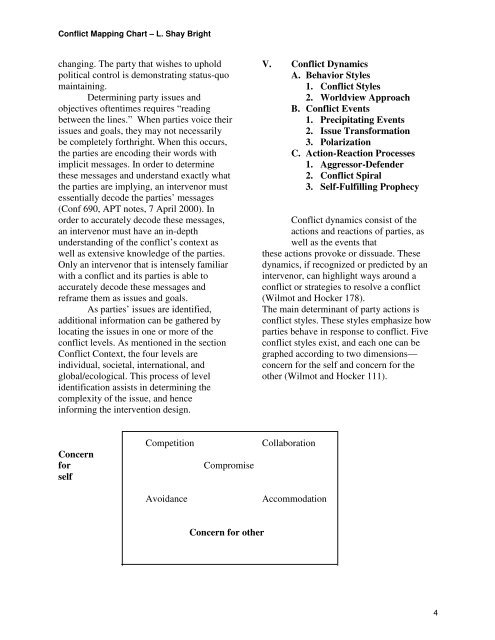The Conflict Mapping Chart By L. Shay Bright To ... - CMSupport.org
The Conflict Mapping Chart By L. Shay Bright To ... - CMSupport.org
The Conflict Mapping Chart By L. Shay Bright To ... - CMSupport.org
Create successful ePaper yourself
Turn your PDF publications into a flip-book with our unique Google optimized e-Paper software.
<strong>Conflict</strong> <strong>Mapping</strong> <strong>Chart</strong> – L. <strong>Shay</strong> <strong>Bright</strong><br />
changing. <strong>The</strong> party that wishes to uphold<br />
political control is demonstrating status-quo<br />
maintaining.<br />
Determining party issues and<br />
objectives oftentimes requires “reading<br />
between the lines.” When parties voice their<br />
issues and goals, they may not necessarily<br />
be completely forthright. When this occurs,<br />
the parties are encoding their words with<br />
implicit messages. In order to determine<br />
these messages and understand exactly what<br />
the parties are implying, an intervenor must<br />
essentially decode the parties’ messages<br />
(Conf 690, APT notes, 7 April 2000). In<br />
order to accurately decode these messages,<br />
an intervenor must have an in-depth<br />
understanding of the conflict’s context as<br />
well as extensive knowledge of the parties.<br />
Only an intervenor that is intensely familiar<br />
with a conflict and its parties is able to<br />
accurately decode these messages and<br />
reframe them as issues and goals.<br />
As parties’ issues are identified,<br />
additional information can be gathered by<br />
locating the issues in one or more of the<br />
conflict levels. As mentioned in the section<br />
<strong>Conflict</strong> Context, the four levels are<br />
individual, societal, international, and<br />
global/ecological. This process of level<br />
identification assists in determining the<br />
complexity of the issue, and hence<br />
informing the intervention design.<br />
Competition Collaboration<br />
Concern<br />
for<br />
self<br />
Compromise<br />
Avoidance Accommodation<br />
Concern for other<br />
V. <strong>Conflict</strong> Dynamics<br />
A. Behavior Styles<br />
1. <strong>Conflict</strong> Styles<br />
2. Worldview Approach<br />
B. <strong>Conflict</strong> Events<br />
1. Precipitating Events<br />
2. Issue Transformation<br />
3. Polarization<br />
C. Action-Reaction Processes<br />
1. Aggressor-Defender<br />
2. <strong>Conflict</strong> Spiral<br />
3. Self-Fulfilling Prophecy<br />
<strong>Conflict</strong> dynamics consist of the<br />
actions and reactions of parties, as<br />
well as the events that<br />
these actions provoke or dissuade. <strong>The</strong>se<br />
dynamics, if recognized or predicted by an<br />
intervenor, can highlight ways around a<br />
conflict or strategies to resolve a conflict<br />
(Wilmot and Hocker 178).<br />
<strong>The</strong> main determinant of party actions is<br />
conflict styles. <strong>The</strong>se styles emphasize how<br />
parties behave in response to conflict. Five<br />
conflict styles exist, and each one can be<br />
graphed according to two dimensions—<br />
concern for the self and concern for the<br />
other (Wilmot and Hocker 111).<br />
4


